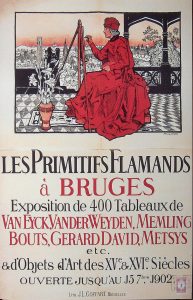Emotional Objects – Northern Renaissance Afterlives in Object, Image and Word, 1890s-1920s
A one-day International Symposium, the Warburg Institute, School of Advanced Studies, University of London, 12-13 June 2020.
Organizer: Prof. Juliet Simpson
 In 1920 Louis Gillet, the French art historian and internationalist published a rousing article defending the repatriation of stolen fragments from the Van Eycks’ Ghent Altarpiece from Germany to Belgium as ‘un drapeau’. His ensign of a Northern patrimony pitched as an emotive call for a different cultural ‘belonging’ post-1918 was part of a pattern. Jean Fouquet’s Melun Diptych was vaunted as both a ‘jewel’, yet the opprobrium of France. At its most charged was the identification of Matthias Grünewald’s Isenheim Altarpiece with extreme War trauma, bodily and mental distress during its 1918-19 Munich display. Yet these Northern Renaissance ‘Afterlives’ remain under-explored. This symposium aims to develop new knowledge of how these and other responses to the Northern Renaissance (in the period spanning the 1890s-late 1920s) become activated via objects, images and words in potently emotive contexts of reception and cultural memory-making to negotiate conflicts of the present.
In 1920 Louis Gillet, the French art historian and internationalist published a rousing article defending the repatriation of stolen fragments from the Van Eycks’ Ghent Altarpiece from Germany to Belgium as ‘un drapeau’. His ensign of a Northern patrimony pitched as an emotive call for a different cultural ‘belonging’ post-1918 was part of a pattern. Jean Fouquet’s Melun Diptych was vaunted as both a ‘jewel’, yet the opprobrium of France. At its most charged was the identification of Matthias Grünewald’s Isenheim Altarpiece with extreme War trauma, bodily and mental distress during its 1918-19 Munich display. Yet these Northern Renaissance ‘Afterlives’ remain under-explored. This symposium aims to develop new knowledge of how these and other responses to the Northern Renaissance (in the period spanning the 1890s-late 1920s) become activated via objects, images and words in potently emotive contexts of reception and cultural memory-making to negotiate conflicts of the present.
Key areas of focus will be to consider the significance of new histories, narratives and emblems of Northern Renaissance visual, material and literary cultures, as well as Northern Renaissance cultural and religious legacies. In particular, the aim will be deeper investigation of their entwining with the cultural modernities of the early twentieth century. Topics for exploration will include – via ideas of ‘canonicity’, exhibitions, collecting; science and art, constructs of nation, internationalism, and in fresh contexts of First World War cultural interventions and their aftermath. A pivotal objective of this symposium will be to bring to new attention, the import of displays and stagings of Northern Renaissance art and visual cultures in Europe and internationally, c.1900-1914, to consider their interactions with Italian and expanded constructs of ‘Renaissance’ (German, French, English), and to ask new questions about their entanglement in an emotional politics of cultural reception and uncanny memory, particularly in the writings of Aby Warburg and his contemporaries, from the early 1900s-to the Weimar Republic close.
Suggested areas for consideration may include but are not limited to:
– Canons and canonicity – writing, reinventing competing ‘Renaissances’ – French, German, Flemish, English/Scottish/Gothic-Renaissance borderlines
– Displaying/Imaging the Northern Renaissance – collections, stagings, interiors, fashions, photography, emblems; mises-en-scènes
– Belief wars: Reformation/Catholic cultural/artistic legacies at the ‘tournant de siècle’/ early twentieth century
– Northern Renaissance cartographies: Ile de France, Venice in the North, Burgundy between North and South; Nordic Renaissances
– Wanderstraßen – Migrating Northern Renaissance Images and Objects in the early 1900s
– Faking it –- artful fictions – reproducing/forging/fashioning the Northern Renaissance
– Lucas Cranach the Elder and Cranachstadt – print, erotics and celebrity
– Renaissances, Memory and Monarchy – Uncanny Châteaux
– Past present – artists and the Northern Renaissance/Northern Renaissances as metaphor
– Northern Renaissances and the First World War – politics, portents and ensigns
– Spoliations/’ownership’
– Objects at war/ touch, sense and thaumaturgic objects
– Dark tourism/intimate talismans
– Renaissances and Apocalypse
– Troubled Arcadias/beyond North-South/West-East polarities
– Renaissance ‘undergrounds’
– Aby Warburg’s ‘Northern Renaissance’
– German Renaissances in the 1920s – transmission, word, image and identities across cultures.
Please send proposals of 300 words (maximum), with a short biography (150 words) to Professor Juliet Simpson, Principal Organizer (Coventry University/the Warburg Institute), juliet.simpson@sas.ac.uk, by 5 April 2020 (midnight GMT).
Applicants will be notified of outcomes by 20 April 2020.
Selection Committee:
Professor Juliet Simpson, Coventry University/Warburg Institute, London
Dr Anna-Maria von Bonsdorff, Finnish National Gallery-Ateneum
Dr Stefan Bauer, Royal Holloway, University of London
Source : https://arthist.net/archive/22766

Leave a Reply
You must be logged in to post a comment.